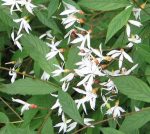 Also called fawn’s breath, bowman’s root and American ipecac, this clump-forming herbaceous perennial is a member of the rose family, Rosaceae, that also includes apple, lady’s mantle, and pyracantha. It is native to eastern North America from Ontario and New England, south to Georgia, Kentucky, and Alabama where it grows in open upland woods and clearings, rocky slopes, and roadsides, mostly in the mountains. Plants grow 2-3′ tall from a woody rootstock and have compound leaves with 3 oblong toothed leaflets up to 4″ long. The leaflets are olive green until fall when they turn bronzy red. From late spring to summer the wiry branching reddish stems carry loose panicles of white to pink flowers. Each star-like flower is 1″ across and has 5 narrow petals and a red calyx that persists into fall after petal drop. Plant are especially attractive when massed and flowers are good in the vase. The genus name, Porteranthus, honors Thomas Conrad Porter, 19th century American botanist, and is combined with the Greek word anthus, meaning flowered. The specific epithet, trifoliatus, comes from the Latin words tri meaning 3 and folium meaning leaf, and refers to the three part nature of the leaves.
Also called fawn’s breath, bowman’s root and American ipecac, this clump-forming herbaceous perennial is a member of the rose family, Rosaceae, that also includes apple, lady’s mantle, and pyracantha. It is native to eastern North America from Ontario and New England, south to Georgia, Kentucky, and Alabama where it grows in open upland woods and clearings, rocky slopes, and roadsides, mostly in the mountains. Plants grow 2-3′ tall from a woody rootstock and have compound leaves with 3 oblong toothed leaflets up to 4″ long. The leaflets are olive green until fall when they turn bronzy red. From late spring to summer the wiry branching reddish stems carry loose panicles of white to pink flowers. Each star-like flower is 1″ across and has 5 narrow petals and a red calyx that persists into fall after petal drop. Plant are especially attractive when massed and flowers are good in the vase. The genus name, Porteranthus, honors Thomas Conrad Porter, 19th century American botanist, and is combined with the Greek word anthus, meaning flowered. The specific epithet, trifoliatus, comes from the Latin words tri meaning 3 and folium meaning leaf, and refers to the three part nature of the leaves.
Type: Herbaceous perennial
Bloom: loose panicles of white to pinkish star-like flowers with 5 narrow petals from late spring to early summer
Size: 2-3′ H x 1.5-3′ W
Light:Ful sun to part shade
Soil: Average, medium moist, well-drained
Hardiness: Zones 4-8
Care: Low maintenance
Pests and Diseases: None of significance
Propagation: Seed, division
Companion Plants: Penstemon smallii, Sisyrinchium angustifolium, Lilium canadense, Silene virginica